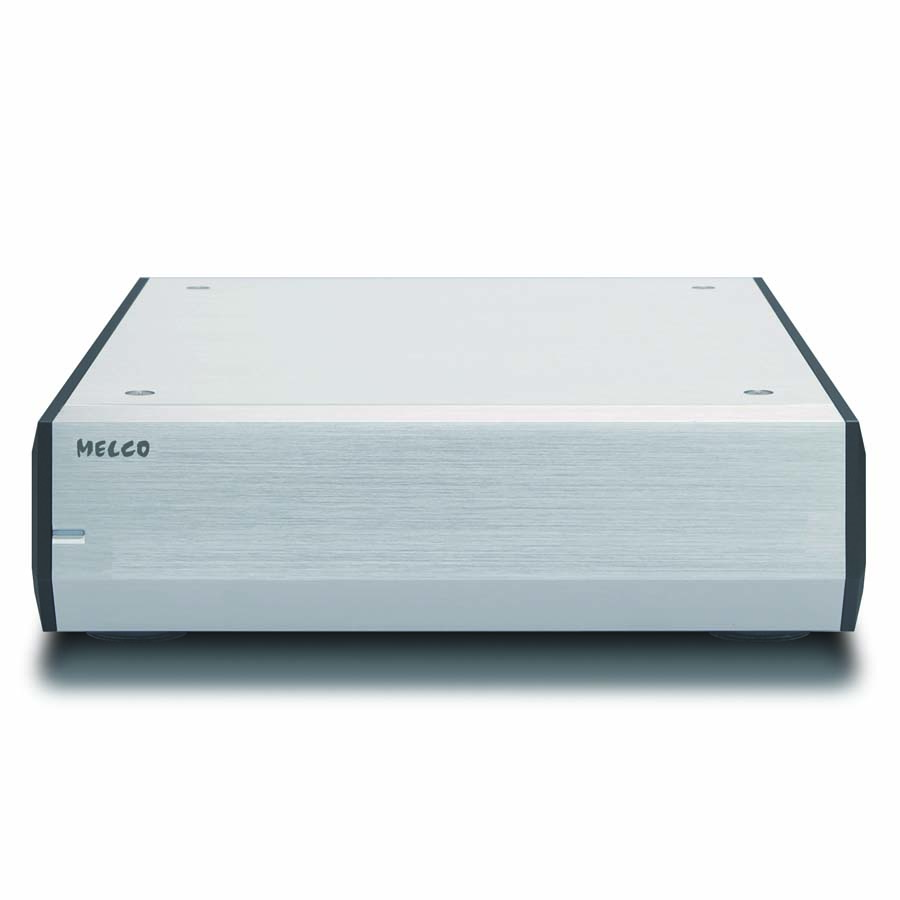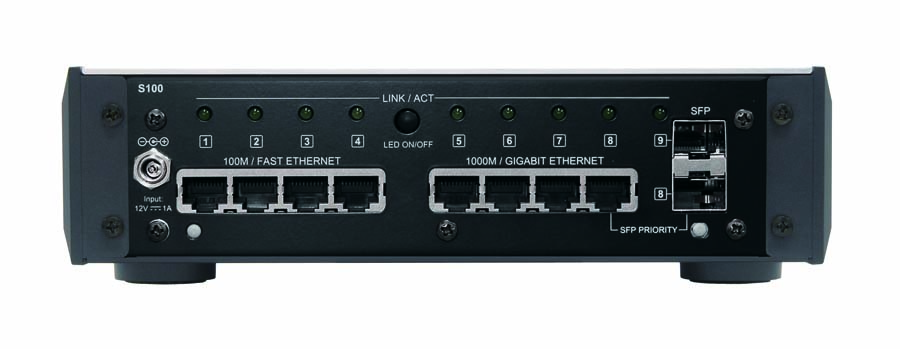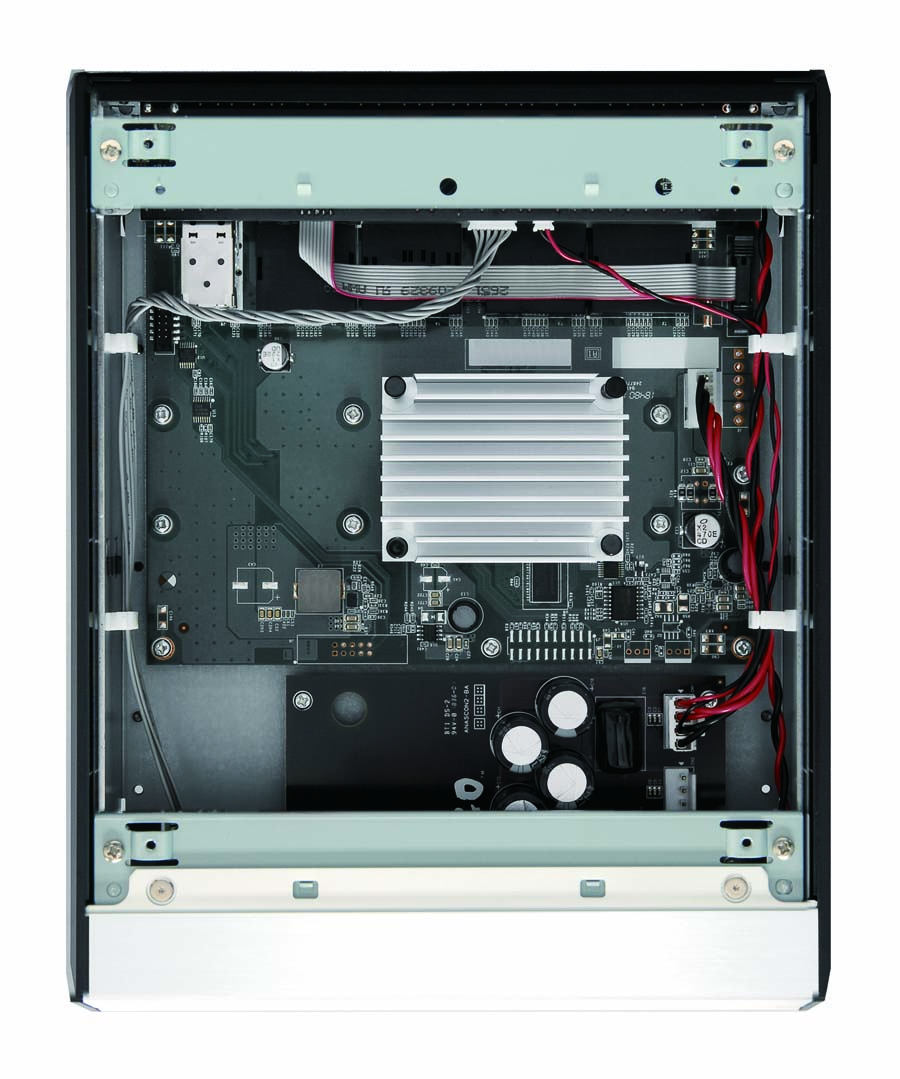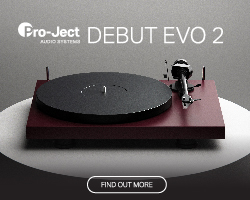MELCO S100 NETWORK SWITCH REVIEW
Melco S100 is a network switch aimed at audiophiles that are serious about their streaming system and their network. Chris Baillie tries it out for HiFi Pig.

The S100 follows Melco’s other small footprint units.
The last twelve months have been a journey of discovery for me into the world of audiophile network switches. In terms of their ability to divide opinions and cause arguments on social media, they seem to be the new audiophile mains fuse. When I bought my first switch, back in 2017, I did so without much consideration. The prevailing wisdom was that it was a good thing to have, in that it would reduce noise by separating the feed to my system from the rest of the traffic on my home network. Helpfully, it allowed me to split the signal from the Ethernet outlet I had run from my router in the office into the living room where my system resides.
When Melco launched the S100 I admit to being a bit confused as I knew there was already a switch in my Melco N1A/2, and so I assumed it would be of no benefit to me. I was in conversation with Alan from Melco at the Bristol Show early last year and took in what they told me regarding the efficacy of S100. However, I still wasn’t convinced it would be the best direction in which to spend the then price of £2000 on my system. Then along came the Silent Angel Bonn N8, which I borrowed from a dealer friend. I was so surprised at how it improved the sound of my set up that I bought it.
You can read, on HiFi Pig, my subsequent reviews of the English Electric 16Switch and RANS-1 from Russ Andrews, where I describe how my system benefited as I moved up the chain. In a way, with the S100, this review is another step in that process.
BUILD QUALITY AND FEATURES
The form of the S100 is in keeping with other half-width Melco products, solidly put together, smart and purposeful. All cable connections are to the rear of the unit, which enables cables to be hidden out of sight. There’s a blue LED at the front, which remains on whilst the unit is powered. The S100 was supplied with the basic (switch mode) power supply. Melco offers a very smart looking Linear PSU upgrade from PLiXiR for £500. There are cheaper options available, but the PLiXiR options do look very smart. Unfortunately, I didn’t get to try one.
Around the back, you have outputs for both 1GB and 100MPS. The 1 GB is better for AV sources, such as smart TV’s where a higher speed data rate is likely to be needed. The 100MPS can offer better performance for some, but not all, audio sources, which don’t need the high-speed connection. Additionally, there are two SFP (Small Form-factor Plugable) sockets, for use with a fibre optic converter, such as the ADOT MC-01, which I have also reviewed in HiFi Pig. The manual suggests one can be used as an output to feed a compatible network player, such as a Lumin with a fibre optic cable. Unfortunately, I wasn’t able to test the S100 in that configuration.

Around the back of the Melco S100.
SOUND QUALITY AND PERFORMANCE
The main listening was carried out using my main home set up – Melco NA1/2 server, Moon 280D DAC, Moon 600i amp, Totem Forest Signature speakers, Tellurium Q Ultrablack II speaker and XLR interconnects, a mixture of Audioquest Vodka, Supra & Chord Ethernet cables. I was also able to connect my Chord Hugo2/2Go to the S100 and listen via my Hifiman Sundara headphones.
I have had the pleasure of testing several audiophile switches in my system over the last few months, so feel this puts me in a good position regarding this evaluation. The S100 replaced the Russ Andrews RANS-1, which I wrote about a couple of months ago. Going up from my own Silent Angel Bonn N8, to the RANS-1 gave a big improvement, but here it was a little more subtle. One of the things I liked about the RANS-1 was that it gave a naturally detailed, yet relaxed presentation. Substituting the S100 built on those qualities, adding another layer of inner detail, possibly making the sense of rhythm and timing more obvious, although perhaps no less accurate overall.
Listening to some of the music I’ve used in my previous reviews of switches, such as Agnes Obel’s Citizen of Glass – 24/44.1 via Qobuz, the music had a little more air and space, giving a slightly more brightly lit presentation than via the RANS-1 and a little more definition to plucked strings, yet still possessing the richness of the RANS-1, which was missing via the other switches I have tested. Moving on to Tony Allen & Hugh Masekekela’s ‘Rejoice’,24/96 via Qobuz, there was a little more ‘rasp’ to the brass instruments and it was slightly easier to follow each musician, especially on the busier tracks.
As with the other switches I have tested, local files also benefited, although to a lesser extent than streamed. Listening to a MoFi SACD rip of the Dead Can Dance classic ‘Into The Labyrinth’, I enjoyed a better sense of recorded acoustic, along with a slightly livelier presentation via the S100 compared to the RANS-1.

Inside the Melco S100
CONCLUSION
The differences between the Melco S100 and a £1,000 switch like RANS-1 or the EE 16Switch, were not night and day, as it was for me moving from the original TP link switch, up to the Silent Angel. but they certainly added to my enjoyment of listening to music. As you can read in my review of the ADOT MC-01 fibre optic converter, the S100 has more to offer when fed via its SFP (Small Form-factor Plugable) input.
Following my previous reviews of audiophile network switches, I have seen many, sometimes heated, comments on social media from people who are unable to accept such devices can make any difference, even suggesting it’s all in the mind. I challenge anyone to listen to what the Melco S100 or the combination of S100 and ADOT MC-01 can do, in a system like mine, and not hear the improvements I have described. These two products have really improved my enjoyment of my system to a significant degree.
Whilst the S100, with its supplied PSU, gave a worthwhile, but not enormous upgrade over the Russ Andrews RANS-1 in my system (though at a cost), I feel this only tells part of the story in that the S100 has considerable potential to upgrade, via the addition of a high quality Linear PSU, or of course the ADOT MC-01 Fibre Optic kit.
If you primarily listen to CD or vinyl, and only stream to discover new music, as indeed many people do, then the expense may not be justified. For someone like me, who’s entire music collection is now stored on a server, with a good deal of listening being via Qobuz, or similar, the S100, especially when combined with the ADOT MC-10 fibre optic kit could add significantly to their musical pleasure. For me it is going to be a very tough decision to make when I am asked to return it.
AT A GLANCE
Sound Quality:
Slightly more air and space than when using other audiophile switches I have used
More inner detail and layering
Build Quality:
Very good build as per Melco’s other products
Value For Money:
A significant increase in price over other switches I’ve used
We Loved:
The boost in cloud streaming performance
The unexpected boost in system performance playing local files
We Didn’t Love So Much:
Cost will mean not all can justify its many charms.
Having to convince your computer savvy audiophile mates that they really need to hear one before judging.
Elevator Pitch Review: The finest network switch I have tried so far in my system, with potential to upgrade to further heights, via addition of the ADOT MC-01 SFP kit and/or an LPSU (Linear Power Supply). It can significantly upgrade the performance of both cloud and local network streaming.
Price: Melco S100 – £2099.00

Chris Baillie















































































































































































































